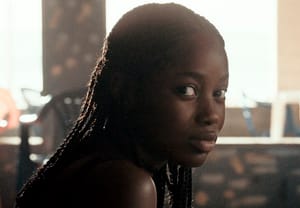
With the Oscar nominations less than a week away, filmmakers vying for Best International Feature Film nominations gathered at the Palm Springs International Film Festival to discuss how they told intensely personal stories that resonate across the globe.
Seven of the 10 films were represented on this occasion: Kantemir Balagov (Beanpole), Mati Diop (Atlantics), Jan Komasa (Corpus Christi), Ladj Ly (Les Misérables), Václav Marhoul (The Painted Bird), Tanel Toom (Truth and Justice), and Barnabás Tóth (Those Who Remained). And while Pedro Almodóvar (Pain and Glory) and Bong Joon Ho (Parasite) were missed, their absence allowed for lesser-known contenders to take center stage.
French-born Diop explained that her debut feature, Atlantics (pictured above), originated from her need to reach back to her African heritage and to allow Senegalese people to tell their own stories, especially those around migration.
Described as seductive and bewitching by critics, the film is a Senegalese ghost story with a teenage girl as a protagonist. “I was the first one to be haunted by the place, people, and the stories that I felt chose me more than I chose them. If I put a spell on the audience, which I truly hope I did, then I was the first one to be under a spell,” said Diop.
Russia’s Beanpole, from 28-year-old Balagov, was prompted by the young director’s discovery of Svetlana Alexievich’s nonfiction novel The Unwomanly Face of War. Filmic references for the World War II story, set in Leningrad, included Mikhail Kalatozov’s The Cranes Are Flying, Larisa Shepitko’s Wings, and Lars von Trier’s Breaking the Waves.
Balagov found inspiration in the intense greens, reds, and rusty tones of Dutch paintings to counteract the suffering on screen. “I was researching personal diaries and I found that people at the time tried to escape the gray reality with colors,” he noted.
Conversely, the Czech representative, Marhoul’s grueling Holocaust drama The Painted Bird, features stark black-and-white cinematography shot on 35mm, and only about nine minutes of dialogue during the film’s nearly three-hour running time. “Every sentence was a picture for me,” said Marhoul, about adapting the highly regarded 1965 novel.
Starring an international cast that includes Palm Springs resident Udo Kier, Stellan Skarsgård, and Harvey Keitel, the movie premiered in Venice, were it received a 10-minute standing ovation.
Meanwhile, Hungary’s Tóth had to deal with writer Zsuzsa F. Várkonyi in order to bring to the screen Those Who Remained, another entry revolving around the Nazi genocide of the Jewish people across Europe.
Though they knew each other personally, Várkonyi was still skepticall about the adaptation because the technical nature of screenplays prevented her from seeing the evocative route the moviemaker would take. She warned him that if she wasn’t satisfied with the end result, he would have to change the names of the characters, which he found a ridiculous request. Thankfully, the author found the cinematic interpretation of her work up to par.
Stakes were even higher for Estonia’s Toom, who departed from one of the most canonical novels in the history of his homeland’s literature. With Truth and Justice he took on the responsibility of creating an audiovisual version of an epic tale widely beloved by Estonians. “That pressure doesn’t help me direct the scene better, so you kind of forget it. You are so 100% into what you are doing,” Toom said.
Asked to describe his drama about a man whose soul gets corrupted in the process of relentlessly pursuing a dream, Toom said: “It’s a two-and-half hour warning movie.”
France’s Ladj Ly grew up in the projects, and as a 17-year-old began documenting police misconduct in his neighborhood. He’s now done it for two decades. “For me this film bears witness to the conditions that have been taking place in the projects for the last 20 years,” said Ly. “A lot is said about the projects and the conditions there, but no one really goes there to see the reality.”
Ly decided that crafting a fiction from the reality he’s been witnessing for so long could have a larger impact, and thus Les Misérables was born.
Poland’s Komasa explored faith via real-life cases of individuals who impersonated priests and were excommunicated. Through the making of Corpus Christi, the artist was confronted with Poland’s southern region, a Bible Belt of sorts were far-right ideologies dominate.
He said the project has healed the split and brought people together, and that some feel the film is an even-handed portrayal of Catholicism, while others feel it’s a necessary critique. For Komasa, the film exists somewhere in the middle.
When questioned about whether filmmakers can use provocation to generate dialogue between opposites sides of any given conversation, Komasa recalled watching Revolutionary Road—starring Leonardo DiCaprio and Kate Winslet as a married couple on the brink of collapse—with his wife, and arguing for several hours after.
“That’s sweet spot for the director, “ he said. “To make people talk about themselves after leaving the cinema.”
Academy Award nominations will be announced on Monday.
Share:

